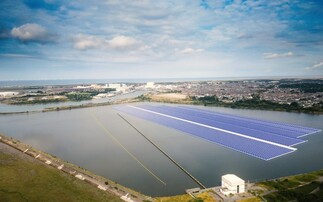The UK may be enduring an unbearably bleak winter, but the UK solar industry at least the future looks positive
Risks are escalating, the threats are severe, and governments have largely failed to adequately protect their societies and economies. That's right, I am of course talking about this week's international Climate Adaptation Summit, which appears to have done better at diagnosing the problem and setting up yet more well-intentioned initiatives than actually triggering the sea change in governance and finance that is urgently needed.
Everything is mostly terrible, so let's try and focus on something more upbeat instead.
Last year was a surprisingly good 12 months for the UK's traditionally embattled solar industry. According to new industry figures released late last week, despite the, erm, disruption of the past 12 months the UK added 545MW of new solar capacity in 2020, up 27 per cent compared to 2019.
This was an impressive achievement given the various lockdowns and economic headwinds, but it was made all the more noteworthy by the fact 2020 was the first full calendar year when the industry had to operate without any form of subsidy support.
Those behind the phase out of subsidies will feel somewhat vindicated that the industry is indeed proving itself capable of standing on its own feet in a posy-subsidy environment. Although those who lobbied for a more measured phasing out of subsidies than the changes that triggered multiple boom and bust cycles over the past decade would no doubt counter that emissions would be lower and the UK's renewables sector would be in better shape (at negligible cost to billpayers) if the government had provided a smoother glide path into the post-subsidy regime.
Either way, the future suddenly looks bright for a solar industry that has endured multiple investment-curtailing, job-destroying setbacks over the past decade, and that's even before you consider the imminent boost from onshore renewables developers being allowed to compete for government-backed clean power contracts at future auctions.
Investors have certainly noticed the potential. Last week saw two more major deals as financiers and project developers team up to deploy new multi-megawatt portfolios. The pipeline of projects in the form of both solar farms and large scale rooftop developments is expanding fast.
As a separate report from influential analysts Wood Mackenzie highlighted, this is part of a global trend. The cost of solar power has dropped 90 per cent over the last two decades, and will likely fall another 15 per cent to 25 per cent in the decade to come, the report predicted.
As such, Wood Mackenzie reckons solar is already the cheapest form of new electricity generation in 16 US states, plus Spain, Italy, and India,and it is likely to be the cheapest option in US state, plus Canada, China, and 14 other nations by the end of the decade.
The report concludes the solar power industry is now "highly investible", which is if anything an understatement.
It is at this point that detractors pipe up with all the old objections about impacts on land use, grid stability, intermittent renewables, and the UK weather proferring their critique with the confidence of a man who thinks no one else has ever noticed that it gets dark at night time.
Some of these concerns are legitimate, but the industry's response to them is more compelling than ever.
Around 40 per cent of new capacity added in the UK last year was on rooftops and there are vast arrays of domestic and commercial south facing roofs still available for development. There is also plenty of brownfield and low quality arable land and developers are getting better all the time at co-locating livestock farming and measures to enhance biodiversity. Meanwhile, those who object to solar farms' impact on farm land remain strangely silent about the golf courses that eat up far more space than the UK's solar fleet.
Plummeting energy storage costs and the nascent hydrogen industry are addressing intermittency concerns, while the emergence of domestic batteries promise to make rooftop solar arrays cost competitive in the coming years.
The UK's high latitude climate may mean that solar technologies are unlikely to provide the backbone to the clean power system, but improving solar PV conversion efficiencies, falling costs, and the way in which solar generation can complement wind generations means they are likely to have a significant role to play.
There are still steps the government could take to ensure UK solar delivers on its potential. As with every UK clean tech sector investment in supply chains and skills would help; the planning system and grid access regime could be made more amenable to clean power capacity that will help the country meet its climate goals; and it remains perverse that VAT on various clean technologies is higher than it is on power and gas provided through the grid.
But even without these reforms, the future suddenly looks a lot brighter for the UK solar industry at least.
A version of this article originally appeared in the BusinessGreen Overnight Briefing newsletter, which is available to all BusinessGreen subscribers.










